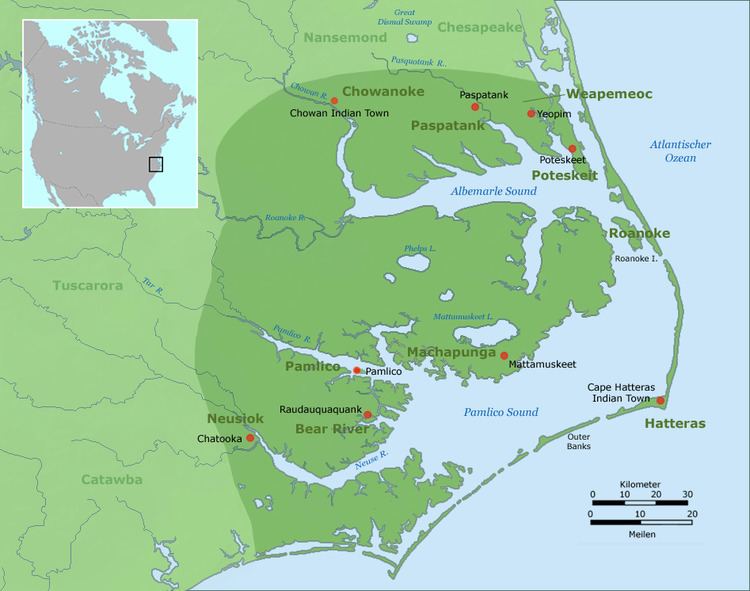Extinct 1790s | ||
 | ||
ISO 639-3 Variously:crr – Carolina Algonquianpmk – Pamlicolmz – ? Lumbee (unattested) Linguist list crr Carolina Algonquian | ||
Carolina Algonquian (also known as Pamlico, Croatoan, or Lumbee) is an extinct Algonquian language of the Eastern Algonquian subgroup formerly spoken in North Carolina, United States. Carolina Algonquian language was formerly spoken by Secotan (later known as Machapunga), Chowanoke and Weapemeoc (subgroups Poteskeit and Paspatank) peoples.
Contents
Translation into English
In 1584 Sir Walter Raleigh had despatched the first of a number of expeditions to Roanoke Island to explore and eventually settle the New World. Early encounters with the natives were friendly, and, despite the difficulties in communication, the explorers were able to persuade "two of the savages, being lustie men, whose names were Wanchese and Manteo" to accompany them on the return voyage to London, in order for the English people to report both the conditions of the New World that they had explored and what the usefulness of the territory might be to the English
Once safely delivered to England, the two Indians quickly made a sensation at court. Raleigh's priority however was not publicity but rather intelligence about his new land of Virginia, and he restricted access to the exotic newcomers, assigning the brilliant scientist Thomas Harriot with the job of deciphering and learning the Carolina Algonquian language., using a phonetic alphabet of his own invention in order to effect the translation.
Related languages
Carolina Algonkian forms a part of the same language group as Powhatan or Virginia Algonquian, a similarly extinct language of the Eastern Algonquian subgroup of the Algonquian language family, itself a member of the Algic language family. Powhatan was spoken by the Powhatan people of tidewater Virginia until the late 18th century, dying out in the 1790s after speakers switched to English.
What little is known of Powhatan is by way of wordlists recorded by William Strachey (about 500 words) and Captain John Smith (about 50 words). Smith also reported a pidgin form of Powhatan, but almost nothing is known of it.
Smith’s material was collected between 1607 and 1609, and published in 1612 and again in 1624. There is no indication of the location where he collected his material. Strachey’s material was collected sometime between 1610 and 1611, and probably written up from his notes in 1612 and 1613, after he had returned to England. It was never published, and remained in manuscript form, although Strachey made a second copy in 1618. The second copy was published in 1849, and the first in 1955.
Legacy
The Carolina Algonquian language is now extinct, and the communities in which it flourished are gone. However, a number of Algonquian loan words have survived by being absorbed into the English language. Among them are: moccasin, moose, opossum, papoose, pecan, raccoon, skunk, squash, squaw, and wigwam.
